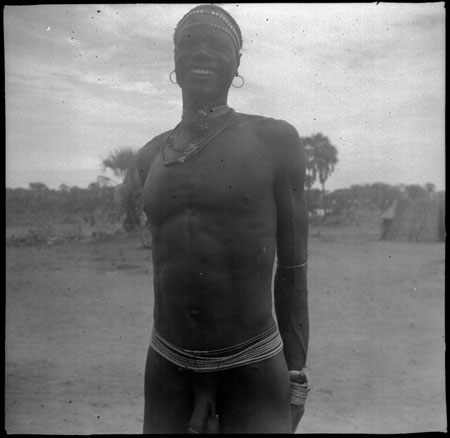Portrait of a Mandari youth

56 x 56 mm | Negative film nitrate
Date of Print:
Unknown
Previous PRM Number:
JB.2.26
Accession Number:
1998.97.44
Description:
A three-quarter length portrait of a Mandari youth, wearing the beaded waist strings of an age set, as well as two decorative flat disk display bands on the forehead and forehead V-shape scarring.
The bead-denoting age sets were not corporate groups in any strong sense and in their names referred to the styles or colour of beads worn by that group.
The pattern of forming age sets was borrowed from the neighbouring Dinka, although neither group initiation nor age-grade raiding were practiced.
Photographer:
Jean Carlile Buxton
Date of Photo:
1950 - 1952
Region:
[Southern Sudan] Bahr el Jebel Tali
Group:
Mandari Dari
PRM Source:
Ronald Carlile Buxton via Institute of Social and Cultural Anthropology
Acquired:
Donated 1988
Other Owners:
Jean Buxton Collection
Class:
Weapon , Ornament
Keyword:
Club , Ornament Body
Documentation:
See Related Documents File. Buxton field notebooks in Tylor Library.
Other Information:
In Some Notes on the Mandari of Equatoria Province, A.E.
Sudan, (typescript notebook of c.1951 in Tylor Library, Institute of Social and Cultural Anthropology, University of Oxford), book I, page 30, Jean Buxton notes that 'Although they are naked, the wearing of beads is very popular.
These are of two different types and mean different things.
There are large strings of circular waist beads of different colours, which have a special significance and denote different age grades, and which can only be worn by an individual when he is in the appropriate age-grade.
The other kind of beads is usually worn around the neck, and is purely ornamental.
They can be worn by anyone, although there are usually set fashion trends which dictate which type of beads it is smart to wear to be up-to-date.
These latter consist of small strings of beads, often worn the whole way up the throat...' [Chris Morton 26/11/2004]
Recorder:
Christopher Morton 26/11/2004 [Southern Sudan Project]

